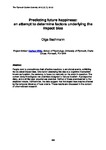Predicting future happiness: an attempt to determine factors underlying the impact bias
| dc.contributor.author | Bachmann, O. | |
| dc.date.accessioned | 2019-05-13T14:23:18Z | |
| dc.date.available | 2019-05-13T14:23:18Z | |
| dc.date.issued | 2010 | |
| dc.identifier.citation |
Bachmann, O. (2010) 'Predicting future happiness: an attempt to determine factors underlying the impact bias', The Plymouth Student Scientist, p. 60-85. | en_US |
| dc.identifier.issn | 1754-2383 | |
| dc.identifier.uri | http://hdl.handle.net/10026.1/13895 | |
| dc.description.abstract |
People tend to overestimate their affective reactions to emotional events, exhibiting the so-called impact bias. One factor underlying this bias is a cognitive mechanism known as focalism, the tendency to focus too narrowly on the event in question. The current study investigates two exercises designed to reduce focalism: A prospective diary, and a similar-past experiences exercise. Neither of these exercises led to the expected results. Furthermore, the data suggest that the impact bias may be affected by the temporal distance of focal events. These results are discussed in the context of other relevant research. | en_US |
| dc.language.iso | en | en_US |
| dc.publisher | University of Plymouth | |
| dc.rights | Attribution 3.0 United States | * |
| dc.rights.uri | http://creativecommons.org/licenses/by/3.0/us/ | * |
| dc.subject | affective reactions | en_US |
| dc.subject | past experiences | en_US |
| dc.subject | focalism | en_US |
| dc.subject | emotional events | en_US |
| dc.subject | impact bias | en_US |
| dc.subject | cognitive mechanism | en_US |
| dc.subject | Happiness | en_US |
| dc.subject | Happy | en_US |
| dc.title | Predicting future happiness: an attempt to determine factors underlying the impact bias | en_US |
| dc.type | Article | |
| plymouth.issue | 1 | |
| plymouth.volume | 3 | |
| plymouth.journal | The Plymouth Student Scientist |



